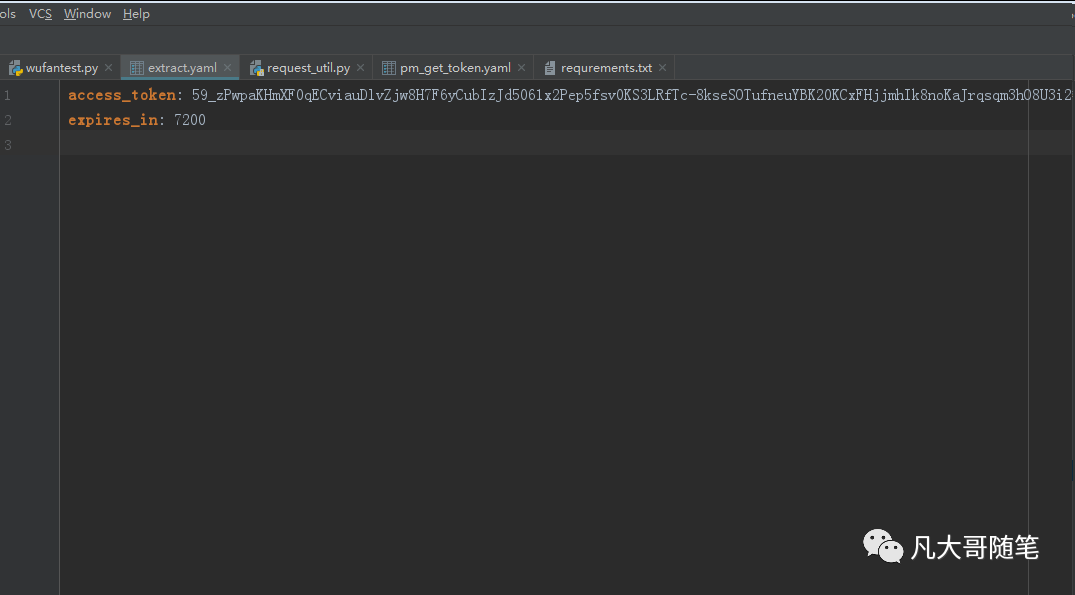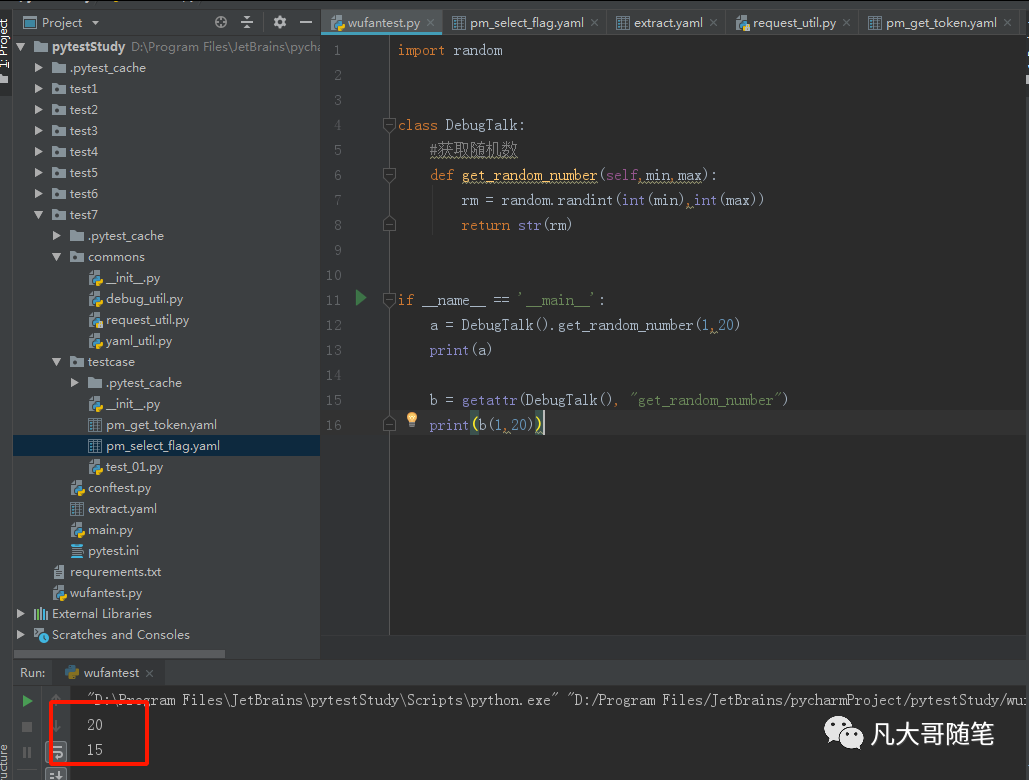-
自动化测试框架Pytest(七)——requests关联数据
第五章我写了个两个方法read_extract_yaml、write_extract_yaml,用来关联接口数据。
今天我们来进一步封装,把要读写的字段都写到yaml文件里,这样测试多个接口我都只需要更改yaml文件,不需要更改代码了。
一、写数据
1、yaml文件新建extract参数,里面填写我需要从当前接口的出参里提取的字段。提取字段有两种方法,第一种是正则提取,第二种是json数据提取,我这个例子里正好一样提取一个。
-name: 获取token鉴权码request:method: geturl: https://api.weixin.qq.com/cgi-bin/tokenparams:grant_type: client_credentialappid: wx8e8b67ced3c4b88secret: XXXvalidate: noneextract:access_token: '"access_token":"(.*?)"'expires_in: $.expires_in2、写文件的代码比较简单,判断yaml文件里是否有extract参数,接着判断提取的字段是正则提取还是json提取。将字段获取之后用write_extract_yaml方法写入到extract.yaml文件即可。
# 提取值并写入extract.yaml文件if "extract" in caseinfo_keys:for key, value in caseinfo["extract"].items():if "(.*?)" in value or "(.+?)" in value:zz_value = re.search(value, res.text)if zz_value:extract_value = {key: zz_value.group(1)}write_extract_yaml(extract_value)else:json_value = jsonpath.jsonpath(return_json, value)if json_value:extract_value = {key: json_value[0]}write_extract_yaml(extract_value)3、保存数据后的extract.yaml文件

二、读数据
1、新建一个pm_select_flag.yaml,该测试用例主要是读取第一个接口输出的access_token,并查询小程序标签。如何去读取extract.yaml的字段呢?这里用了${read_extract_data(xxx)}
-name: 查询小程序标签request:method: geturl: https://api.weixin.qq.com/cgi-bin/tags/get?access_token=${read_extract_data(access_token)}validate: none2、读取代码要稍微复杂一点,这里先学习一个小知识,python的getattr,该方法可以直接调用某一个类里的方法:
import randomclass DebugTalk:#获取随机数def get_random_number(self,min,max):rm = random.randint(int(min),int(max))return str(rm)if __name__ == '__main__':a = DebugTalk().get_random_number(1,20)print(a)b = getattr(DebugTalk(), "get_random_number")print(b(1,20))可以看到这两个方法都能调取DebugTalk里的方法。

3、在RequestUtil里新建一个replace_value的方法,该方法的作用是看到yaml文件里有${AAA(xxx)},就去执行DebugTalk的AAA方法。这里的${read_extract_data(xxx)}就是去执行DebugTalk的read_extract_data方法。
# 替换值的方法def replace_value(self, data):# 1保存数据类型data_type = type(data)# 2判断数据类型if isinstance(data, dict) or isinstance(data, list):str_data = json.dumps(data)else:str_data = str(data)# 替换for cs in range(1, str_data.count('${') + 1):if "${" in str_data and "}" in str_data:start_index = str_data.index("${")end_index = str_data.index("}", start_index)old_value = str_data[start_index:end_index + 1]# print(f"old_value:{old_value}")# 反射:通过类的对象和方法字符串去调用方法function_name = old_value[2:old_value.index('(')]args_value1 = old_value[old_value.index('(') + 1:old_value.index(')')]if args_value1 != "":args_value2 = args_value1.split(',')# print(function_name, args_value2)new_value = getattr(DebugTalk(), function_name)(*args_value2)else:new_value = getattr(DebugTalk(), function_name)()# print(f"new_value:{new_value}")# 判断替换的新参数的类型if isinstance(new_value, int) or isinstance(new_value, float):str_data = str_data.replace('"' + old_value + '"', str(new_value))else:str_data = str_data.replace(old_value, str(new_value))# 3还原数据类型if isinstance(data, dict) or isinstance(data, list):data = json.loads(str_data)else:data = data_type(str_data)return data4、更改统一请求的封装,请求之前将请求头和参数里的${AAA(xxx)}全部替换成实际值。
def send_request(self, method, url, **kwargs):method = str(method).lower()url = self.replace_value(url)# 请求头和参数替换for key, value in kwargs.items():if key in ['params', 'data', 'json', 'headers']:kwargs[key] = self.replace_value(value)print(f"kwargs[key]:{kwargs[key]}")elif key == "files":for file_key, file_path in value.items():value[file_key] = open(file_path, 'rb')res = RequestUtil.session.request(method,url,**kwargs)return res5、完整的request_util.py 读写代码:
import jsonimport reimport requestsimport jsonpathfrom test7.commons.debug_util import DebugTalkfrom test7.commons.yaml_util import write_extract_yamlclass RequestUtil:session = requests.session()# 替换值的方法def replace_value(self, data):# 1保存数据类型data_type = type(data)# 2判断数据类型if isinstance(data, dict) or isinstance(data, list):str_data = json.dumps(data)else:str_data = str(data)# 替换for cs in range(1, str_data.count('${') + 1):if "${" in str_data and "}" in str_data:start_index = str_data.index("${")end_index = str_data.index("}", start_index)old_value = str_data[start_index:end_index + 1]# print(f"old_value:{old_value}")# 反射:通过类的对象和方法字符串去调用方法function_name = old_value[2:old_value.index('(')]args_value1 = old_value[old_value.index('(') + 1:old_value.index(')')]if args_value1 != "":args_value2 = args_value1.split(',')# print(function_name, args_value2)new_value = getattr(DebugTalk(), function_name)(*args_value2)else:new_value = getattr(DebugTalk(), function_name)()# print(f"new_value:{new_value}")# 判断替换的新参数的类型if isinstance(new_value, int) or isinstance(new_value, float):str_data = str_data.replace('"' + old_value + '"', str(new_value))else:str_data = str_data.replace(old_value, str(new_value))# 3还原数据类型if isinstance(data, dict) or isinstance(data, list):data = json.loads(str_data)else:data = data_type(str_data)return data#规范YAML测试用例def standard_yaml(self,caseinfo):caseinfo_keys = caseinfo.keys()# 判断关键词是否完整if "name" in caseinfo_keys and "request" in caseinfo_keys and "validate" in caseinfo_keys:cs_request = caseinfo['request']cs_request_keys = cs_request.keys()if "method" in cs_request_keys and "url" in cs_request_keys:method = cs_request.pop("method") #pop-删除列表里最后一个并且返回这个值url = cs_request.pop("url")res = self.send_request(method,url,**cs_request)print(res.text)# 写入yaml文件return_json = ""try:return_json = res.json()except Exception as e:print("返回的结果不是json格式,不能使用jsonpath提取")# 提取值并写入extract.yaml文件if "extract" in caseinfo_keys:for key, value in caseinfo["extract"].items():if "(.*?)" in value or "(.+?)" in value:zz_value = re.search(value, res.text)if zz_value:extract_value = {key: zz_value.group(1)}write_extract_yaml(extract_value)else:json_value = jsonpath.jsonpath(return_json, value)if json_value:extract_value = {key: json_value[0]}write_extract_yaml(extract_value)return reselse:print("二级关键字必须包含:method,url")else:print("一级关键字必须包含:name,request,validate")#统一请求封装def send_request(self, method, url, **kwargs):method = str(method).lower()url = self.replace_value(url)# 请求头和参数替换for key, value in kwargs.items():if key in ['params', 'data', 'json', 'headers']:kwargs[key] = self.replace_value(value)print(f"kwargs[key]:{kwargs[key]}")elif key == "files":for file_key, file_path in value.items():value[file_key] = open(file_path, 'rb')res = RequestUtil.session.request(method,url,**kwargs)return res三、实际效果
第一个接口生成的access_token给第二个接口使用,使用成功。


学习资源分享
最后感谢每一个认真阅读我文章的人,看着粉丝一路的上涨和关注,礼尚往来总是要有的,虽然不是什么很值钱的东西,如果你用得到的话可以直接拿走

这些资料,对于做【软件测试】的朋友来说应该是最全面最完整的备战仓库,这个仓库也陪伴我走过了最艰难的路程,希望也能帮助到你!凡事要趁早,特别是技术行业,一定要提升技术功底。希望对大家有所帮助…….
如果你不想再体验一次自学时找不到资料,没人解答问题,坚持几天便放弃的感受的话,可以加入下方我的qq群大家一起讨论交流,里面也有各种软件测试资料和技术交流。
-
相关阅读:
图片怎么转换成PDF格式?这两种方法赶紧记下
Cholesterol-PEG-DBCO,CLS-PEG-DBCO,胆固醇-聚乙二醇-二苯基环辛炔PEG衍生物
网络架构学习1
设计模式:迭代器模式
Zabbix监控
海康监控视频无插件开发3.2版本运行demo
数据结构之查找
网络接口登录方法获取cookie
Ubuntu搭建Mqtt服务器
探花交友_第9章-我的功能实现
- 原文地址:https://blog.csdn.net/m0_58026506/article/details/126386056